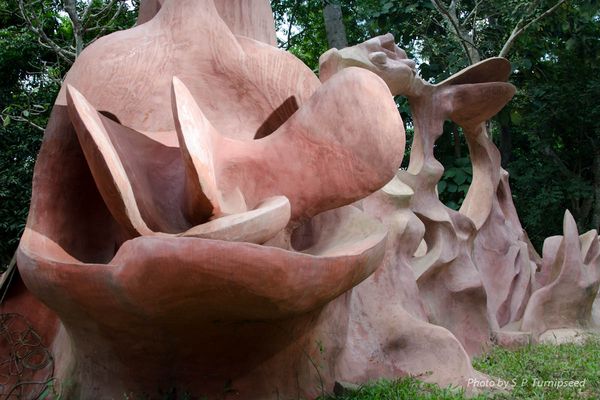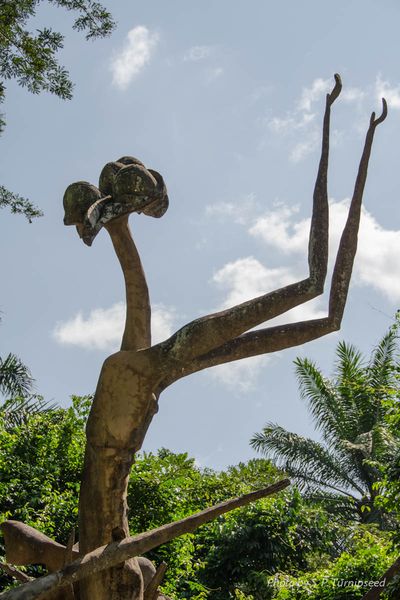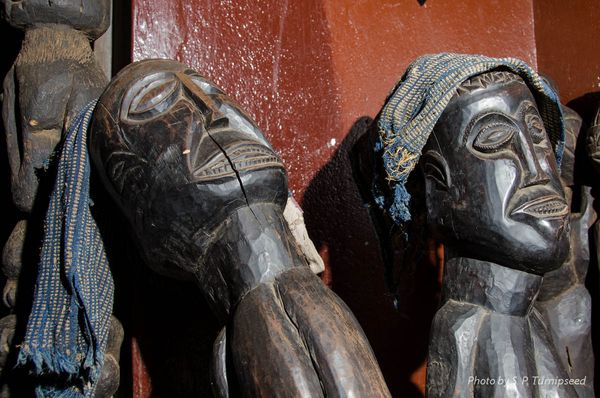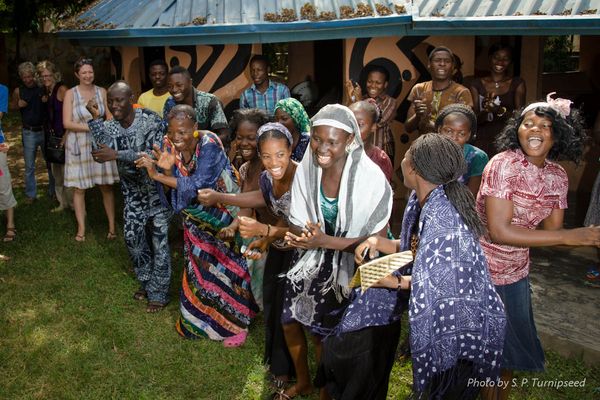Trip to: Osogbo, Osun State, Nigeria
Date: 17th – 18th November, 2012
Trip Organisers: Hugh and Robin Campbell
Trip Report: M. Ogunsulire
Introduction
On the 17th of November 2012, a group of about eighteen NFS members travelled to Osogbo town in Osun State, Nigeria for a two-day visit. The highlight of the trip was a tour of the Sacred Groves of Osogbo, which are a UNESCO World Heritage Site.
The Sacred Groves of Osogbo make up a sacred forest historically set aside as a dedicated place of worship for the people of Osogbo. Several Yoruba deities are worshipped within this sanctuary, but the area has special significance for the adherents of Osun, the Yoruba river-goddess, believed to dwell in the famous Osun River that bisects the sacred forest.
Osogbo was also home to Susanne Wenger, the famous Austrian-born artist who settled there in the 1950s. She became a Yoruba priestess and shrine-builder and eventually devoted her life to Yoruba Traditional religion and the preservation of the Sacred Groves. Susanne led the New Sacred Art Movement, a group of artists who created the impressive shrines, statues and sculptures which are a unique feature of the sanctuary. She died in 2009, at the age of 94, having spent most of her life in her adoptive home of Osogbo. The Sacred Groves were named a UNESCO World Heritage site in 2005, four years before she died.
Day 1 – The Sacred Groves
We set off for Osogbo early, at about 8am on Saturday. Thanks to Jeffrey, a comfortable coaster bus had been made available to the NFS group for the trip, and we all settled in. Robin thoughtfully provided books about Susanne Wenger and the Sacred Groves, which she circulated in the bus. The journey to Osun State was mostly uneventful, except for a major bottle neck on the Lagos-Ibadan road. We arrived at the Osogbo Groves at about noon and had a picnic lunch in a shady clearing just outside the sacred groves with monkeys swinging from the trees overhead!
Not long afterwards, the two custodians of the grove, Priest Sangodare Ajala and Priestess Doyin Faniyi arrived. The custodians are adopted children of Susanne Wenger, whom they still warmly refer to as ‘Mama’. Sango and Doyin are priests of Sango and trustees of the Adunni Olorisha Trust founded by Susanne to protect the Groves. They welcomed us to Osogbo and we set off with them to explore the Groves and the art within.

The first sculpture we saw was ‘Iyamapo’ a representation of a deity with 6 arms, standing over 12 feet tall. The wooden scaffolding surrounding this sculpture showed that it was undergoing restoration, but it was still impressive. Priestess Doyin explained that statue represents a female deity, one with many children, and ever busy (hence the six arms).
The next statue was ‘Ela’ a youthful incarnation of Alajere, the intermediary between Earth and Sky. The sculpture was an imposing height –at least 20 feet tall; a befitting stature for an emissary to the Sky God. Guided by the custodians of the Grove, we saw many more creations representing Yoruba deities.

There were also shrines dedicated to various deities. Many of the shrines that we saw had flesh-pink, womb-like walls, with narrow or irregular entry ways, which evoked the mysterious nature of these places of worship. Serene, yet majestic, they were at one with the groves that they inhabited.
As we hiked through the thick foliage and grass in the sacred forest, it was easy to see why Susanne felt at one with nature in this place. We were aware of the birds, insects and other inhabitants of the forest, as we pushed our way through almost virgin paths. As we walked, Priest Sangodare pointed out herbs and plants that are traditionally used to cure specific ailments and maladies.

We heard the Osun River a few minutes before we could see it, and saw a rusty chair on its banks. It was Susanne’s chair, Sangodare explained. ‘Mama’ had loved to sit on the banks and meditate; occasionally, she even slept by the river. Standing on the river banks, with nothing but the sound of the water, and the refreshing breeze, one could understand why Susanne chose to meditate there.
On the other side of the river, we witnessed two women praying to Osun, invoking her protection and seeking favours. As they prayed, they threw food and gifts into the water as an offering to the River-Goddess.
Nearly three hours after we had arrived, we ended our tour of the Sacred Groves of Osogbo. The shrines and statues that we had seen on our tour were awe-inspiring tributes to Yoruba art and spirituality.
Day 1 – Susanne Wenger’s House
After we left the groves, we visited the three-story house in Central Osogbo, where Susanne Wenger lived for 60 years. The first thing we noticed about the three-story house was the stone lace-work that decorated the waist-high fence in front of the house. From the fence, the figures and engravings of people, animals and birds spilled on to the stone walls of the house, adorning wooden shutters and doors, as well as balconies. It appeared that every available surface had been decorated with these interesting carvings. Framed by the bougainvillea growing against the left side of the house, and the large cactus on the right, the decorated stone house was incredibly charming.
Like most traditional Yoruba homes, Susanne’s house was a communal dwelling, which she shared with her adopted children. We were warmly welcomed by her adoptive family, who reside in the house and have preserved her personal effects and large collection of art. We also met several members of the New Sacred Art Movement (NSAM). With warm smiles and laughter, these remarkably unassuming artists and artisans told us about themselves and shared personal anecdotes about ‘Mama’ and how they came to join the NSAM.
We ended our visit with a tour of the house, which was filled with numerous wooden statues. On every floor were statuettes and totems collected by Susanne from the various towns and villages that she visited in Nigeria. We were encouraged to wander freely through the hallway, corridors and communal areas. On the top floor, Priestess Doyin carefully unlocked the door to ‘Mama’s’ bedroom. Here, more statuettes surrounded a narrow single bed, and bookcases stood against the reddish brown walls which were just a shade darker than the walls of the shrines we had seen in the sacred groves.
After a quick visit to the small gift shop on the ground floor, we departed at about 5.30pm in a flurry of good-byes and were waved off by children in neighbouring houses, who had made friends with the children in our group.
Day 1 – Cultural Performance at Nike’s Guest House
Tired after the day’s activities, we all looked forward to the opportunity to rest at Nike’s Guest House, owned by Ms. Nike Davies Okundaye. Her large compound was surrounded by beautiful pink and purple bougainvillea, and as we climbed out of the bus, we were greeted with loud cries of ‘Ekabo!’ which means welcome in Yoruba. Led by Nike herself, our hosts enthusiastically clapped their hands and danced as they welcomed us!

That evening, we were treated to a feast of at least twenty dishes, including roasted guinea fowl, ‘bush meat’ and a cooked snake. We were also served some of the sweetest oranges and pineapples that I have ever tasted. It was announced that one of our group had her birthday that day, and we sang ‘Happy birthday’ to her and toasted her health.
Pleasantly replete from our meal, we repaired to the courtyard where we enjoyed performances by cultural dancers, drummers, and an introduction to Bata, which is a Yoruba ‘talking drum’. We were also introduced to the staff of the guesthouse and Nike’s art apprentices.
The highlight of the evening was when each NFS member was given a Yoruba name and asked to dance to the drums. As each name was called, the person would step into the circle and dance as we chanted their name to the drums. Nike’s announcement that prizes would be awarded to the best dancers, really heated up the competition, and great fun was had by all, as our group showed off their dancing skills!! The first prize went to 7-year old Seth, who reprised his performance at the end of the competition, and received an ovation from everyone.
Day 2 – Morning Walk
The following morning, we had breakfast in Nike’s large and beautiful garden surrounded by flowers. A peacock and two tortoises wandered around the grounds as we ate. After breakfast, we had an hour or so to spare, so a number of us strolled into town with Robin to visit a personal gallery run by the artist, xxxxxxx. He showed us his print art works and talked to us about the creative process and technique of wood block printing, which is his preferred medium.
Day 2 – Visit to Nike’s Dye Workshop and Gallery
Shortly after 10am, we left the Guest-house for a quick visit to Nike’s Workshop, where we were again welcomed by cries of ‘Ekabo!’ We watched a wood-carver at work, and then the artisans at the shop demonstrated the techniques used to design batik print. Afterwards, Nike herself showed us vats of the locally produced indigo dye which is used to create Adire and Batik cloth, while she described the traditional process of preparing the dye.

Our final stop in Osogbo was Nike’s Art Gallery, a large two-storey building with spiral steps leading directly from the frontage to the upper floor. The gallery was a cornucopia of beautiful paintings, locally made cloth, striking wall-hangings, and furniture. We spent an hour browsing the shop and many NFS members bought souvenirs, before we finally boarded the bus for Lagos at a few minutes past noon.
Conclusion
After an uneventful drive, we arrived safely in Lagos shortly before 4pm. We all agreed that it had been an amazing trip. Many thanks to our Osogbo hosts and everyone who contributed to the success of the trip.
Our greatest thanks go to Hugh and Robin Campbell, who planned and organised a fantastic cultural experience!
